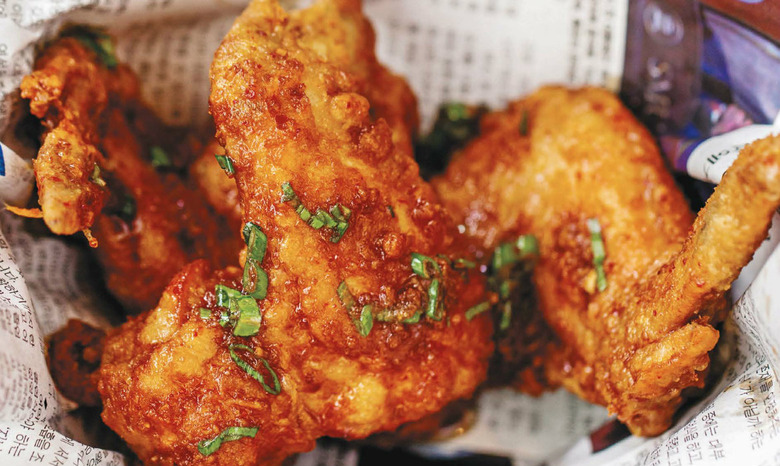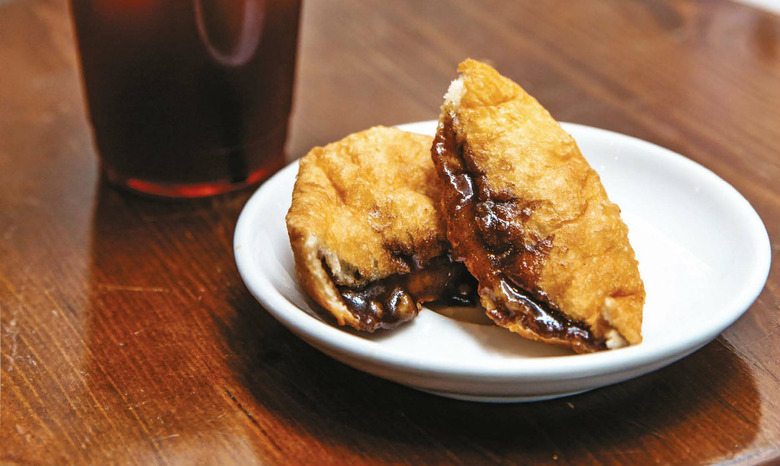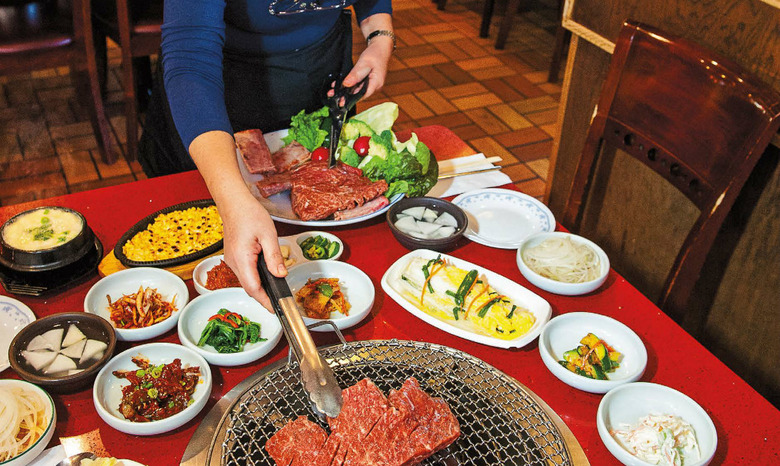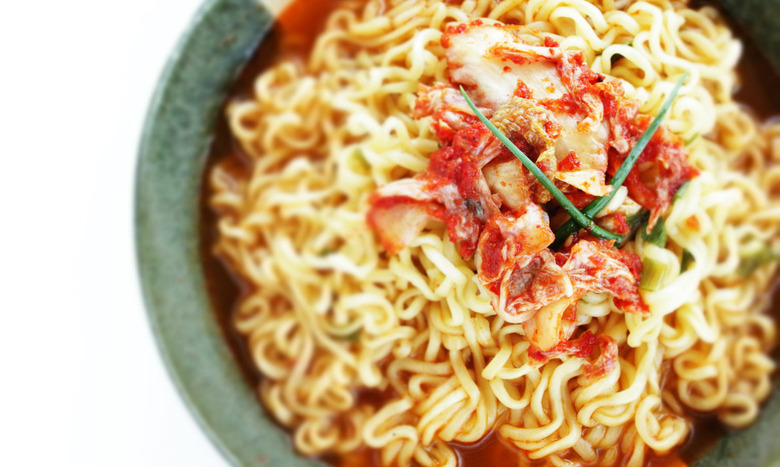'Koreatown: A Cookbook' Shines A Spotlight On Korean Food In America
"Our book stands as this kind of gateway between traditional Korean cooking and the chef community," says food writer Matt Rodbard about Koreatown: A Cookbook that he wrote with Korean-American chef Deuki Hong.
To be fair, this book isn't another cookbook from that Michelin-starred restaurant, although Hong and Rodbard did dine at Michelin-starred Korean restaurant Parachute in Chicago during their two-year exploration of Koreatowns across America. The book is sensory, approachable, and full of life. From the buzzing, vibrant Koreatowns of Los Angeles and New York City to every lone-standing establishment serving Korean-American food along the way, this book shines a spotlight on one type of Asian cuisine that has been largely overshadowed by American's consumption of Japanese sushi, Chinese dim sum, and Thai curry.
It is the first book of its kind, Rodbard reminded me as we talked, and as the only Korean food book written from the perspective of "Koreatown," it had a lot to accomplish within its covers. The headnotes tell the long, proud history of Korean food in America, and the recipes that define it; while the pictures show real food and the very real people that cook, eat, and call it their own.
We had the opportunity to talk with Rodbard about what writing this book meant to him and Hong on a personal and a cultural level:
The Daily Meal: What drew each of you to writing a book about Korean food?
Matt Rodbard: We met working on a small guide book project where we were asked to review a bunch of Korean restaurants in New York City. For me personally, I have been drawn to Korean food for a long time. My best friend from college is Korean, so we would go to restaurants in college, and then he moved to New York around the same time as me, and we would go to restaurants in Flushing, Queens, and, of course, in Koreatown in Manhattan. He would take me to these restaurants, and I was just so blown away by how delicious the food was, but also by how magical and mysterious it was. It was almost like he was decoding this world that I didn't know existed, as a food writer I was interested in this, which is why I kind of decided to focus on this book project.
In the introduction to the book, you mention that while Asian cuisine has become widely popular throughout the U.S., Korean food's popularity with the general public has lagged behind. I know I didn't even try Korean food until I moved to New York. Why do you think Korean food hasn't caught on like Japanese ramen and Chinese dim sum?
I think this is a really good point to bring up because Asian food is exploding in America. You have seen Thai cooking become as well-known as hamburgers and hot dogs. You know, there is a Thai restaurant on every corner; everyone knows sushi, but I think in general Korean food has been kind of ignored and slightly shoved to the side, simply because the Korean chefs have not done a very good job marketing themselves for the general public. Korean food just has not been marketed as much as the other cuisines and that is because the Korean chefs and restaurant owners have been creating this "for us, by us" mentality with their food. They have been proudly cooking their cuisine, but not necessarily intending for it to be eaten by everyone. I think a word that comes to mind when talking about Korean food is humble. It's a cuisine that is not flashy. The restaurants are fairly modest, especially when you go to the restaurants outside the big cities. You might have one or two Korean restaurants in Philly; you have one or two Korean restaurants in Madison, Wisconsin; one or two in Oklahoma City. So, you've got these very modest Korean restaurants that aren't being marketed that well.
Do you see this lack of marketing and accessibility of the food to the general public changing at all in the near future?
Yeah, yeah. With all that being said, it is changing dramatically. You have Korean-Americans that are cooking with those same traditional ingredients and techniques. For example, Parachute in Chicago is a restaurant run by a Korean-American. [Beverly Kim] was nominated for a James Beard Award along with her husband [Johnny Clark]. She is cooking this very modern-style Korean-American cuisine, and I think you are going to see more and more chefs, like Beverly Kim at Parachute, doing this.
The photographs in this book are all very candid and real. Can you talk a little bit more about the purpose of this? What were you trying to show?
We wanted the book to not be shot in a studio. We wanted a more documentary approach to the cuisine. It's not the idealized Koreatown, it is the real Koreatown. With that in mind, we went into each of the restaurants with our photographer Sam Horine, and shot documentary-style. We wanted to show the food as it is intended to be eaten, which is with rough edges, not perfect knife cuts, with the vivid colors and real flavors. We hope that the readers can almost smell and sense the vibe of these restaurants through the photography, opposed to a lot of cookbooks that are studio-shot, and the dishes look like they are meant to be shown in a museum — they are perfect — our book is not necessarily like that. We wanted to be different, and we wanted to tell a story.
How did you settle on the recipes you wanted to include in this book? How did your travels and personal experiences with Korean food dictate this?
One of the first things that came to mind when we were going through our recipes list was that we wanted to focus on soups and stews. We didn't want is to be all about the barbecue. Korean food is very soup- and stew-focused. Those are the dishes that you eat every day. If you are a Korean-American, you are either making them at home or eating them in a restaurant. Barbecue is more of a once a week, once a month kind of thing. We wanted to reflect that with the recipe list, so if you look at the soups and stews section, there are 25 recipes in there. We really wanted to focus on these dishes, like Samgyetang, a ginseng chicken soup, which is a little bit milder than the Kimchi Jjigae the really robust flavor-bomb soups that you are typically thinking about with Korean food. Another example is jogaetang, which is a spicy clam soup. Again, it is a fairly light broth, it's not that robust, kimchi, sour flavor. We wanted introduce new flavors and styles of cooking to the public.
The other area we wanted to focus on was "drinking food." Koreans like to drink. It is part of the culture, so when you go to Koreatown, there is a lot of soju and beer flowing. We added this whole section called pojangmacha, which is kind of a Korean bar. We have this lineup of dishes that are meant to be consumed or eaten with the consumption of alcohol. It was really important to us to dive into that culture and the drinking food of Korea.
One more would be our "Kimchi & Banchan" section, the first section in the book. Most people know what kimchi is, it's the cabbage dish — and that certainly is one type — but there is also many other types of kimchi. There is cucumber kimchi, daikon radish, red kimchi, daikon radish white kimchi. We wanted to dive into all the small plates that arrive right before the meal.
You touch on this at the beginning of the book, but ordering food can be overwhelming, especially if you aren't familiar with the cuisine. What is your advice to hungry food-obsessed patrons testing out their first Korean restaurant? What classics should they order?
Well, when you go to a Korean restaurant for the first time, and you don't have your Korean friend with you to help order — a lot of people will go to Korean restaurants with their friend and their Korean friend wants to take them, that's how I was first introduced. If you aren't that lucky, talk to your server. Tell them you are interested in trying some soups and stews that are really good, maybe not necessarily barbecue, or have a little bit of barbecue. Definitely order seafood. I think that is something a lot of people don't consider. They think beef or barbecue, but seafood is so fundamental to the cuisine. So maybe order an anchovy broth or clam soup.
Were there any people or restaurants in particular that stuck out when you were visiting different spots for this book?
Los Angeles is the largest, and the most active Koreatown in America, so there are a lot of restaurants there I love. One is called Soban that is a favorite of mine. They do raw crabs that are marinated that are so delicious. We got our friend who owns Seoul Sausage, which is run by these three, young, Korean-Americans that's on the opposite end of the spectrum. It's not a traditional restaurant; it's more of a modern-style restaurant. They are making Korean-style sausage. It started as a food truck and now they are opening a restaurant in downtown L.A. in a beautiful space. Further out, around the country, there is a place in Atlanta, Georgia, called Heirloom Barbecue that is owned by a Korean-American Jiyeon Lee with her husband Cody Taylor, and they do Korean-style Southern barbecue. So, low-and-slow, smoked barbecue, but with Korean flavors, like doenjang rubbed ribs and miso brisket. I mentioned Parachute in Chicago that is a favorite of mine. Back in New York, there is a restaurant called Her Name is Han on 31st Street that I really, really love. It feels like Seoul. It's just a very modern take on Korean dishes. It has a really, I don't like to use the word authentic, but it has a really real feel to it like it could have been dropped down from Gangwon-do.
How do you hope readers will use this book?
I hope readers will first read through the words that we have cobbled together. I mean cookbooks are made to be cooked with, but you are going to learn a lot more from reading it, potentially putting it on your coffee table and reading it, and then cooking a favorite dish from it. Not putting the pressure on yourself to cook from it. Just pick it up and read it and you are going to learn not just how to make a soup, but also how to order in a restaurant. Learn a little bit about the dishes. I hope people go through and read the headnotes and learn a little background about the soups and stews and drinking food — so that is the first hope.
But also, if we could get one person to make a barbecue marinade, and do it in the way in which we think is right — which is making the marinade one day, letting it sit a day in the fridge, and then putting it on the meat for the second day — making it a two-day process. We hope people will take our advice on that.
Cooking from it, a lot of the dishes are one-pot and they take less time than you think they would. People will get that and try some of the soups, and not be intimidated. Also, a lot of the ingredients are so readily available; it is not a lot of diving into foreign terms.
What is the ultimate take-away for readers?
Korean food is here in America, and it is a very important part of food culture. As I said in the beginning, Korean food hasn't really taken the spotlight. Understand that this eating culture and food culture is very proud and very rich, and this is the moment for it to step in to the spotlight. We feel strongly about that. Also, Korean food isn't as technical as you might think; it is a lot of one-pot soups. Also, Korean-Americans are a big part of America that population is a big part of everyday life. It would be cool for a lot of Americans who maybe don't know a lot about Asian food to really dig into Korean food, and take note that it is part of our culture and a part of America.
Want to try a recipe?
Dakgangjeong (Koreatown Fried Chicken)
When it comes to the art of frying chicken, Koreans could give Southerners a run for their money. There, said it. Korean fried chicken (KFC) chains have set up shop in the Koreatowns of New York, Chicago, Atlanta and Los Angeles. KFC combines savory, spicy glazes and skin that shatters like glass. And guess what? We have the secret. Booyah! — Deuki Hong and Matt Rodbard
For the Dakgangjeong (Koreatown Fried Chicken) recipe, click here.
Hodduk (Korean Sweet Fried Pancake)
Hodduk is sort of a cross between a donut and a pancake that can be served as a sweet snack or dessert. Though sometimes filled with red beans or sweet potato, our move is nuts, brown sugar and cinnamon, which come together nicely as a gooey center. We typically make a large batch of the dry ingredients (you can easily triple or quadruple this recipe) and keep it in individual containers for easy use. And we suggest serving this with a scoop of vanilla ice cream. — Deuki Hong and Matt Rodbard
For the Hodduk (Korean Sweet Fried Pancake) recipe, click here.
Kalbi (Korean Marinated Short Ribs)
Make the marinade a day ahead, and let it sit in the fridge overnight, and then apply it to the meat on the second day.
For the Kalbi (Korean Marinated Short Ribs) recipe, click here.
Spicy Kimchi Yuba “Noodles” With Poached Egg
The question of Stuart Brioza's love of kimchi is answered with a trip up a wobbly ladder to a secret loft space turned fermentation lab above his insanely popular San Francisco restaurant, State Bird Provisions. In this crawl space, we spotted large buckets of napa cabbage and daikon radish kimchi, which the chef makes year-round using chopped-up Beausoleil oysters. "I'm a Bay Area kid, so the idea of mixing cultures comes naturally to me," he says, sipping an espresso in the restaurant's sunny dining room. We're talking about the marriage of Japanese yuba—the delicate skin that forms on top of soy milk while making tofu—with Korean kimchi, a dish he has served since the early days of State Bird, and one that has become one of the restaurants' signatures. — Deuki Hong and Matt Rodbard
For the Spicy Kimchi Yuba "Noodles" With Poached Egg recipe, click here.



